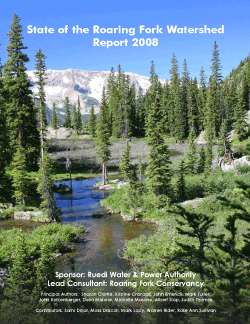Entire Report
Cover, Table of Contents, Acknowledgements
Chapter 1 - Preface and Introduction
Chapter 2 - Regional Water Management
Chapter 3 - Water Topic Overview
3.1 Water Quantity
3.2 Water Quality
3.3 Riparian Areas
3.4 Instream Areas
3.5 Climate Change
Chapter 4 - Water Resource Discussion by Sub-watershed
4.0 Water Resource Discussion by Sub-watershed
4.1 Upper Roaring Fork Sub-watershed
4.2 Upper Middle Roaring Fork Sub-watershed
4.3 Lower Middle Roaring Fork Sub-watershed
4.4 Lower Roaring Fork Sub-watershed
4.5 Maroon/Castle Creek Sub-watershed
4.6 Snowmass/Capitol Creek Sub-watershed
4.7 Fryingpan River Sub-watershed
4.8 Crystal River Sub-watershed
4.9 Cattle Creek Sub-watershed
Chapter 5 - Next Steps
Chapter 6 - Appendices
Appendix List
All Appendices - As One Document
Appendix 1.1 Reviewers and Authors
Appendix 1.2 Climate Stations
Appendix 1.3 Riparian and instream species of concern
Appendix 1.4 County Land Use Codes
Appendix 1.5 Pitkin County Caucus Information
Appendix 2.1 Citizen's Guide to Colorado Water Law 2nd Edition
Appendix 2.2 CWCB Instream Flow Roaring Fork Watershed
Appendix 2.2a Snowmass Creek CWCB Instream Flow
Appendix 2.3 Natural Lake Levels Roaring Fork
Appendix 2.4 CWCB ISF
Appendix 2.5 RICDS
Appendix 2.6 Fry-Ark and IPTDS Water Rights and Bypass Flows
Appendix 2.7 River District's Conditional Water Rights Maps
Appendix 2.8 Colorado Basin Roundtable Members
Appendix 3.1.1 Stream Gages
Appendix 3.1.2 Hydrologic Alteration
Appendix 3.1.3 Water Suppliers
Appendix 3.1.4 SWSI Water Conservation
Appendix 3.1.5 IHA
Appendix 3.1.6 Rafting Flows
Appendix 3.1.7 RFMOS and Basalt River Master Plan
Appendix 3.2.1 Water Quality Data
Appendix 3.2.2 Water Quality Trilinear Plots
Appendix 3.3.1 Instream and Riparian Condition Chart
Appendix 3.3.2 Roaring Fork PCAS CNHP 2008
Appendix 3.3.2 Roaring Fork PCAS CNHP 2008
Appendix 3.3.2a Data Dictionary for PCA reports
Appendix 3.3.3 Background Riparian Information
Appendix 3.4.1 USFS MIS Data
Appendix 3.4.2 Background Instream Flow Info
Appendix 3.5.1 Climate Change Influence on Water Temperature, Stream Flow and Trout
Appendix 4.1 Open Space Information
Appendix 4.3.1 BWCD Missouri Heights Ground Water Program Conclusions
Appendix 4.4.1 Glenwood Springs River Management Plan
Appendix 4.8.1 Carbondale Municipal Code Relevant to Water Resources
Chapter 7 - Glossary and Acronyms
Chapter 8 - References

